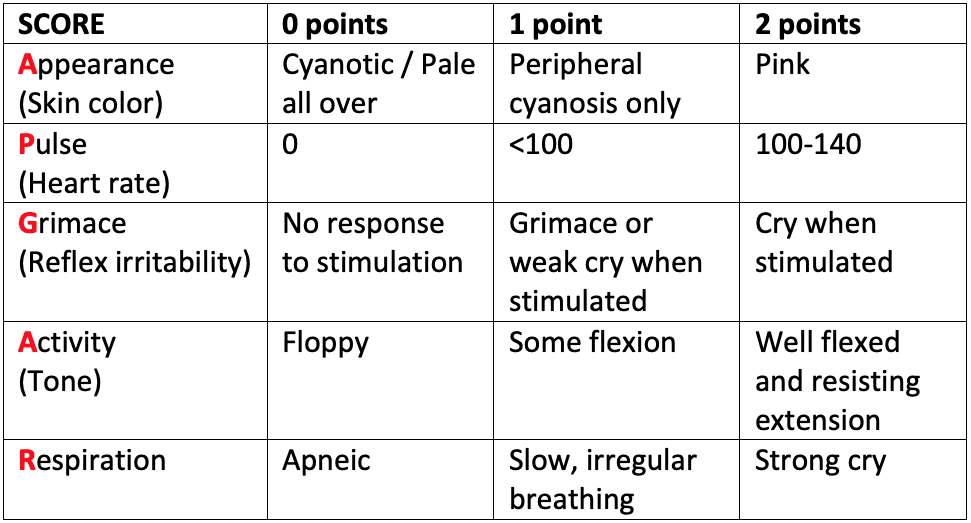Apgar Score
Description
The APGAR scoring system is a comprehensive screening tool which should be used to assess newborns at birth and can assist in identifying the need for any immediate attention/ intervention that baby needs. A practical method to evaluate the condition of a new born by using five simple signs. APGAR is the backronym for the eponym.
Appearance, Pulse, Grimace, Activity, Respiration
Each of the above is given a score of 0, 1 or 2, resulting in a score of 0 to 10.
The newborn is scored by a doctor or midwife at both 1 minute and again at 5 minutes after birth. It is widely recognised that a score of 7-10 is normal, 4-6 is moderately abnormal and 0-3 is abnormal. Any score of lower than 7 should alert the medical practitioner to consider whether the baby requires any intervention.
History of the Apgar Score
From her experience in the delivery room and in anaesthesia, Virginia Apgar (1909-1974) noticed that the first moments of a newborn’s life were crucial but despite this there was no standard protocol for assessing the viability of a baby.
Apgar chose five standard variables; heart rate, respiratory effort, reflex irritability, muscle tone and colour that could be easily used to assess the condition of a new born baby.
Over a period of three years she applied this scoring system to thousands of deliveries and realised that it was a useful test to estimate the viability of a newborn.
1953 – Apgar Published ‘A Proposal for a New Method of Evaluation of the Newborn Infant’.
1961 – Apgar received a letter from Dr Joseph Butterfield a professor at the Colorado University in Denver which informed her that one of his residents had devised a most fortunate backronym connecting the five letters of her surname to the five evaluations of the newborn…APGAR
Associated Persons
- Virginia Apgar (1909 – 1974)
Controversies
Original work published by Apgar in 1953 described the five variables as heart rate, respiratory effort, reflex irritability, muscle tone and colour. Despite practitioners using the score to as a guide to assessing their resuscitation efforts or as a predictor of morbidity/mortality, the primary use of the APGAR score has always been to evaluate a newborn’s condition at birth.
In 1966 Apgar evaluated some additional research that had been done into the scoring system as well as its use as a predictor for morbidity and mortality. Apgar recommended that an observer other than the one delivering the baby should assign the score and that although it had been shown that mortality and the presence of significant neurological dysfunction correlated better with the five minute score than the one minute score, prompt assessment of the newborn is crucial in identifying the need for any immediate treatment that might be required.
References
Original articles
- Apgar V. A proposal for a new method of evaluation of the newborn infant. Curr Res Anesth Analg. 1953; 32(4): 260-7.
- Apgar V. Infant Resuscitation. Postgrad Med. 1956 May;19(5):447-50
- Apgar V, Holaday DA, James LS, et al. Evaluation of the newborn infant; second report. J Am Med Assoc. 1958 Dec 13;168(15):1985-8
- Apgar V. The newborn (Apgar) scoring system. Reflections and advice. Pediatr Clin North Am. 1966; 13(3): 645-50.
Review articles
- Jepson HA, Talashek ML, Tichy AM. The Apgar score: evolution, limitations, and scoring guidelines. Birth. 1991; 18(2): 83-92.
- Montgomery KS. Apgar Scores: Examining the Long-term Significance. J Perinat Educ. 2000; 9(3): 5-9.
- Pearce JM. Virginia Apgar (1909-1974): neurological evaluation of the newborn infant. Eur Neurol. 2005;54(3):132-4.
- McKennedy C. The APGAR score – Eponym A Day. Instagram
[cite]
the names behind the name
Lowri Bowen. Mwynhau fy mhrofiad Awstralia, ond rwyf yn caru cymru yn fwy | LinkedIn |


